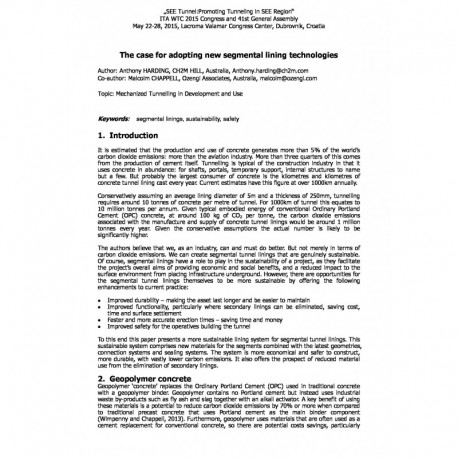Cart
0
0
No document
0,00 €
Total
Document successfully added to your shopping cart
Quantity
Total
There are 0 items in your cart.
There is 1 item in your cart.
Total documents
Total shipping
To be determined
Total
Search & filter
Search for a publication
Search & filter

The case for adopting new segmental lining technologies
wtc2015_full_harding
It is estimated that the production and use of concrete generates more than 5% of the world’s carbon dioxide emissions: more than the aviation industry. More than three quarters of this comes from the production of cement itself. Tunnelling is typical of the construction industry in that it uses concrete in abundance: for shafts, portals, temporary support, internal structures to name but a few. But probably the largest consumer of concrete is the kilometres and kilometres of concrete tunnel lining cast every year. Current estimates have this figure at over 1000km annually. Conservatively assuming an average lining diameter of 5m and a thickness of 250mm, tunnelling requires around 10 tonnes of concrete per metre of tunnel. For 1000km of tunnel this equates to 10 million tonnes per annum. Given typical embodied energy of conventional Ordinary Portland Cement (OPC) concrete, at around 100 kg of CO per tonne, the carbon dioxide emissions associated with the manufacture and supply of concrete tunnel linings would be around 1 million tonnes every year. Given the conservative assumptions the actual number is likely to be significantly higher. The authors believe that we, as an industry, can and must do better. But not merely in terms of carbon dioxide emissions. We can create segmental tunnel linings that are genuinely sustainable. Of course, segmental linings have a role to play in the sustainability of a project, as they facilitate the project’s overall aims of providing economic and social benefits, and a reduced impact to the surface environment from placing infrastructure underground. However, there are opportunities for the segmental tunnel linings themselves to be more sustainable by offering the following enhancements to current practice: Improved durability – making the asset last longer and be easier to maintain Improved functionality, particularly where secondary linings can be eliminated, saving cost, time and surface settlement Faster and more accurate erection times – saving time and money Improved safety for the operatives building the tunnel To this end this paper presents a more sustainable lining system for segmental tunnel linings. This sustainable system comprises new materials for the segments combined with the latest geometries, connection systems and sealing systems. The system is more economical and safer to construct, more durable, with vastly lower carbon emissions. It also offers the prospect of reduced material use from the elimination of secondary linings.



